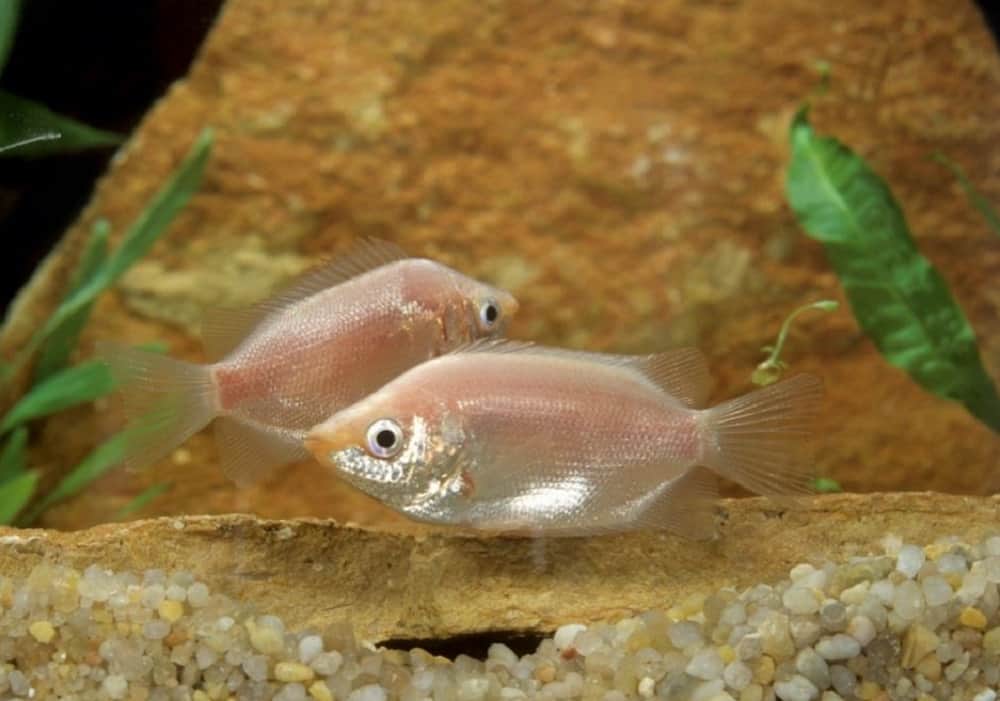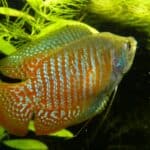Kissing Gourami are a fascinating species of freshwater fish with a unique appearance and intriguing personality. They are medium in size, and suitable for aquarists with intermediate experience or perhaps ambitious beginners.
If you are considering adding them to your aquarium, or you want to find out more about this particular species, then keep reading! This article will provide you with plenty of information on their dietary habits, behavioural traits, tank requirements, appearance and much more.

Species Summary
Kissing Gourami are named for their distinct lips that pucker when they are eating or fighting. Their name is not sweet and romantic as it might suggest.
These fish are endemic to Indonesia, but can also be found in the slow moving waters in Borneo, Cambodia, Thailand, Malaysia and Vietnam. In these areas the fish are caught and eaten by the locals. Most of the fish sold for domestic aquariums will have been bred in captivity.
Care Guide
Tank Size
The bigger the better for Kissing Gourami, as they enjoy swimming and can be territorial. It is recommended to provide them with 50 to 75 gallons of water, but the more space you can provide them the happier your fish will be.
Tank Mates
Avoid housing Kissing Gourami with fish that are smaller than them as they will likely bully them. They are more likely to show aggression towards fish that look like them, so don’t house them other species of gourami that aren’t kissing gourami.
Try swordtails, tiger barbs, chinese algae eaters, angelfish or pictus catfish.
Same Species Tanks
Kissing Gourami can live with members of their own species if the number of males is limited and they have plenty of space to avoid territorial disputes.
If there is not enough space or too many males then there will be too much aggression within the group, which will increase stress levels amongst the community.
Water Parameters
Kissing Gourami are accustomed to slow moving water so ensure the pump in your tank is not too strong. They are one of few species of fish who have a labyrinth organ.
This allows them to extract as much oxygen as possible from the water and even enables them to suck air from the surface of the water. This means it is possible for them to survive in low oxygen environments.
The temperature of the water should be within 72 to 82 degrees fahrenheit. The PH level of the water should be between 6.8 and 8.5, and the water hardness 5 to 20KH. Make sure you test the water frequently to maintain the right conditions.
What To Put In Their Tank
The Kissing Gourami’s natural habitat are ponds with a rich abundance of plant life, so vegetation is the most important thing to include in their tank.
But they will eat delicate plants right down to the stem so be sure to choose hardy plants like java fern or java moss or use plastic ones they can’t eat. Leave plenty of open space in their tank for swimming.
Choose fine gravel or sand for the substrate level. The fish can accidentally ingest large amounts of sand when eating, so mixing the substrate with large rocks or chunkier pieces of gravel can help prevent this and can stop the sand from being pushed around too much.
Include some smooth surfaces like large pebbles and driftwood as they enjoy scraping the algae off with their small teeth.
The final thing to remember is to leave 1 to 2 inches of air at the top of the aquarium, as they need this to suck air from the surface.
Common Diseases
Kissing Gourami are vulnerable to the same diseases and parasites as other freshwater fish such as ich and fin rot. But they are also susceptible to ‘hole in the head’ disease, an unpleasant ailment which causes pits and sores on the skin. These sores can allow bacteria into the body and need to be treated quickly.
To avoid your fish getting sick, maintain the correct water parameters and tank conditions to keep your fish stress free. Keep the tank clean and the levels of ammonia and nitrates low.
Food & Diet
Kissing Gourami are omnivorous freshwater fish that like to feed on algae off smooth surfaces. They also have gill rakers to filter plankton and other microorganisms from the water. But you should supplement the food they find themselves with dry flakes and pellets, and blanched vegetables like spinach, lettuce and zucchini.
To add protein into their diet, give them occasional live or frozen food like shrimp and bloodworms.
Lifespan
Kissing Gourami have been known to live up to 25 years in the wild. Their average lifespan in captivity is 7 years. You can maximise the lifespan of your fish by providing them with optimum tank conditions.
Appearance
The Kissing Gourami have a distinct and unique appearance. They have large lips that protrude from their mouth rather than being angled upwards or downwards. They also have extra joints in their jaw which provide flexibility. They are able to open their mouths extra wide to let in more food.
Kissing Gourami have tall slender bodies with spiny dorsal and anal fins that extend across the full length of the body. They are known for their bright coloring.
The standard color is silvery green, with variations of pattern including faded stripes or dark green flecks that produce a mottled appearance. There is a genetic mutation that makes them silver pink in color. This color has become commercially popular and is being bred purposefully to meet demand.
Size
In the wild, Kissing Gouramis will reach lengths of up to 12 inches. In a domestic tank, they will often grow to 6 inches in length, but may grow bigger if the tank is large with plenty of space.
Behaviour & Temperament
Kissing Gouramis have slim bodies which make them very agile swimmers. They have a semi-aggressive temperament and are known for being territorial. They are likely to bully other tank members, especially smaller fish, by pushing them around.
They are also known to eat the slime layer from the skin of other fish by ramming them with their mouths, which leaves the other fish vulnerable to diseases.
Male Kissing Gouramis will fight other males in the tank, which involves pushing each other with their mouths. It doesn’t usually cause injury but can lead to increased stress levels which can lead to disease. The fight stops when one fish backs down.
Kissing Gouramis are more likely to show aggression to fish that look like them, like other gouramis, but they can live with their own species if the number of males is limited.
They are active swimmers and spend most of their time on the top and middle sections of the tank.
Breeding
It is quite easy to breed bonded pairs, but they will need to be moved to a separate breeding tank. The temperature of the water should be higher to replicate the spawning season, around 80 degrees, and the water should be softer than in the main tank. Feed the bonded pair with live food to create the mood for breeding.
When the time is right, the female will turn over onto her back and lay the eggs. The male often assists her by wrapping his body around her and flipping her over.
The eggs are buoyant and float to the surface of the water, the male fertilising them as they rise.
By placing a large lettuce leaf on the surface of the water this should capture the scattered eggs and provide them with shelter.
As soon as the eggs have been fertilized, remove the adults from the tank or they will eat the eggs.
The eggs hatch quickly, often within a day. The small fry will eat the egg sac. Once they are able to swim freely, usually another day or two, they can be fed with powdered food and then newly hatched brine shrimp.
Gender Differences: Male vs Female
There aren’t any noticeable differences between male and female Kissing Gouramis. The only real way to differentiate them is change in shape of the female when she is carrying eggs- her body becomes much rounder.
Fun Facts
- Kissing Gouramis are bred in Thailand and Singapore to be sold for aquariums and eaten as food.
- As well as the pink mutation, there is also a mutation which makes them shorter and rounder, but this sadly shortens their lifespan.








